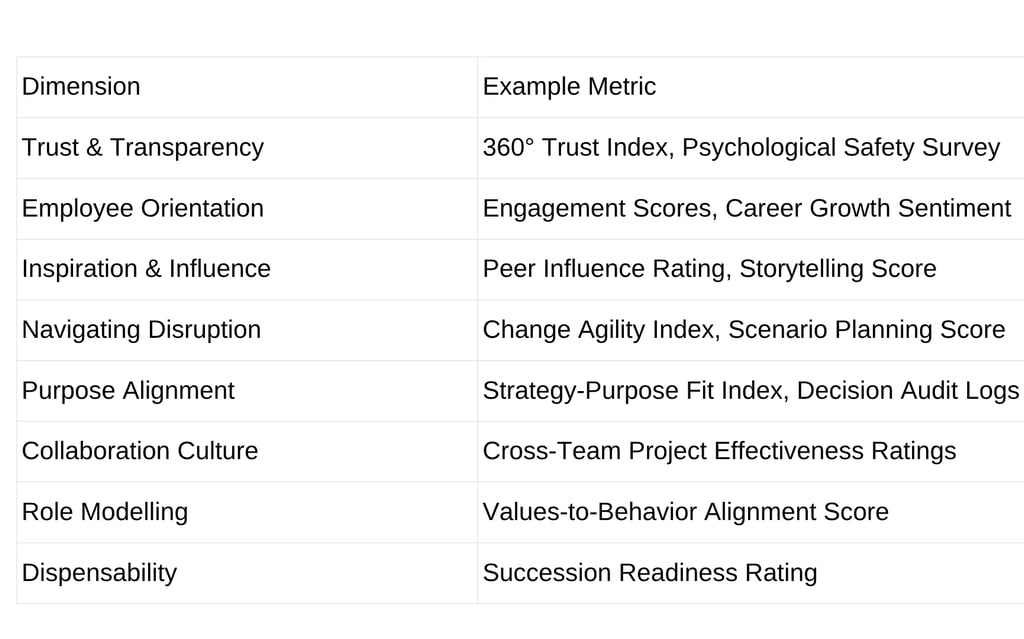Redefining Leadership: What Should Leaders Really Be Measured On?
Discover why traditional leadership metrics like KPIs and OKRs no longer reflect what makes great leaders. Explore a new leadership scorecard focused on trust, culture, growth, and purpose. Learn how to measure what truly matters in the modern workplace.
Nivarti Jayaram
7/3/20253 min read


“We’re measuring outputs and missing humanity.”
In an era where burnout is rising and purpose is disappearing, are we measuring leadership all wrong? In this provocative blog, leadership strategist and cultural architect Nivarti Jayaram explores why traditional performance indicators—like KPIs, OKRs, and productivity stats—miss the human essence of leadership.
Drawing insights from Brené Brown, Adam Grant, Simon Sinek, and McKinsey’s Great Attrition report, this article introduces a powerful shift: from managing outputs to cultivating impact. You’ll uncover why modern leadership should be measured not by deliverables alone but by trust, inspiration, psychological safety, adaptability, and how leaders role model behavior and build successors.
This blog offers:
A breakdown of outdated leadership metrics—and their cultural cost
A fresh, research-backed leadership scorecard
Reflective questions for evolving your leadership practice
Tools to create people-first cultures and purpose-aligned teams
If you’re a leader, coach, HR professional, or change-maker ready to rethink how leadership is defined, developed, and measured—this blog is your blueprint. It’s not just about what leaders achieve. It’s about what they amplify in others.
For decades, organizations have proudly tracked leadership performance through KPIs, OKRs, and MBOs—growth, profitability, productivity, customer satisfaction, and cost savings. But what if the act of measurement itself fails to capture the essence of what makes leadership valuable?
The Problem with “What” Without “How”
As Brené Brown says in Dare to Lead, “Clear is kind. Unclear is unkind.” Organizations have long been clear about what they expect from leaders, but not how to achieve it. This ambiguity is not merely a failure in soft skills; it represents a rift in culture that is rapidly expanding.
Take the findings from the 2021 Global Leadership Forecast:
Only 11% of HR heads say they have a strong leadership bench.
44% of leaders report burnout.
86% of high-potential employees are at risk of burning out.
These aren’t just HR statistics. These are red flags for systems under duress—symptoms of cultures that measure “winning” but not well-being.
What Gets Measured… Shapes Us
Peter Drucker famously said, “What gets measured gets managed.” But what if what we’re managing is killing innovation, loyalty, and long-term value?
Adam Grant, in Think Again, challenges us to reexamine assumptions. Here’s one: “Leaders are successful if they hit their targets.” Let’s rethink that. What if we define leadership success by:
How they foster growth in others
How resilient their teams are after setbacks
How trusted and safe people feel around them
It’s not about discarding performance—it’s about integrating humanity into performance.
The Leadership Gap: A Culture Problem
McKinsey’s 2021 report The Great Attrition or the Great Attraction? revealed that people are leaving not just jobs—but toxic environments. Employees crave:
A renewed sense of purpose
Human connection, not just transactional relationships
A culture of inclusion, recognition, and psychological safety
Culture is what leaders create in the micro-moments: the way they give feedback, manage conflict, model vulnerability, and prioritize people.
“Leadership is not about leading people. It’s about being a leader.” — Nivarti Jayaram
The Real Measures of Leadership
1. Trust and Transparency
Trust isn’t binary. David Maister’s Trust Equation—Credibility + Reliability + Intimacy ÷ Self-Orientation—offers a powerful lens to assess trust.
2. Inspiration and Influence
Modern leaders don’t command—they inspire. Influence in today’s world stems from authenticity, curiosity, and courage to learn publicly.
3. Employee Orientation
Putting people first doesn’t mean compromising business—it enables it. Employee-centric leaders coach, connect, and co-create success stories.
4. Navigating Disruption
The pandemic wasn’t the exception—it’s the prototype of future volatility. Leaders must be adaptive, resilient, and willing to unlearn.
5. Distributed Leadership
Agility demands decentralization. Leadership must be embedded in every level of the organization—not hoarded in the C-suite.
6. Role Modelling
People don’t follow advice. They follow example. Emotional agility, humility, and the courage to say “I don’t know” are the real flex.
7. Being Dispensable
The mark of great leadership? They make themselves unnecessary. They build successors, not silos.
8. Purpose-Driven Action
Purpose isn’t a poster on the wall—it’s a pattern of decisions that align with a greater “why.”
From Metrics to Meaning: A New Leadership Scorecard
Here’s what a holistic leadership measurement framework might look like:
Shift the Lens
“Take care of the people, and they’ll take care of everything else.” — Nivarti Jayaram
It’s time to redefine leadership metrics not as checklists but as culture-shaping levers. What we measure tells people what matters. If we want people-first organizations, we need leader-first cultures—not leader-as-boss, but leader-as-builder, cultivator, learner, and steward of purpose.
This change isn’t just a leadership evolution. It’s a human revolution.
Further Reading
Books
Think Again – Adam Grant
Dare to Lead – Brené Brown
Reinventing Organizations – Frederic Laloux
Atomic Habits – James Clear
The Fearless Organization – Amy Edmondson
Leadership on the Line – Ronald Heifetz & Marty Linsky


